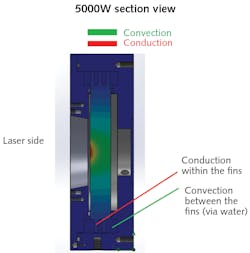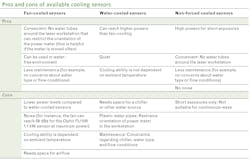When selecting a laser power measurement sensor for a particular application, choosing the right heat-control method for the sensor is a key consideration. To aid in such a choice, this article will review the different cooling technologies used in high-power laser measurement sensors. It will also examine the changing requirements of the cooling system as the power levels of the laser increase, and consider how these are met by fan and water cooling methods. In addition, this article will compare the different cooling requirements of a pulsed laser measurement sensor and a continuous-wave (CW) laser measurement sensor, and discuss the technologies that make it possible to use a non-forced-cooled sensor—a sensor without a fan or water cooling—to measure high-power lasers.
Convection and conduction
Convection is a process in which heat transfers from once place to another via a fluid such as water or air. There are two different types of convection—natural and forced convection.
Natural convection occurs when heat is transferred without any additional force moving the fluid, so the fluid moves naturally by gravity only. Examples include the movement of steam coming out from a hot cup of tea, and the movement of cold and hot water in a cup; being less dense, the hot water moves towards the top, while the cold water moves towards the bottom. The hot water, now at the top, transfers its heat to the air and cools down, while the cold water at the bottom heats up; the resulting current continuously moves the heat out of the cup.
Forced convection occurs when a force is added to increase the movement of the fluid, such as by using a fan or a water pump.
With conduction, heat is transferred within a solid material, in which the rate of heat transfer is pretty much constant (depending on the thermal conductivity of the specific material and the geometric design of the solid). With convection, on the other hand, there is much more opportunity to optimize the heat evacuation rate. For example, this can be done by controlling the speed of the fluid (using forced convection), changing the dimension of the area that is in contact with the fluid, controlling the fluid’s temperature, and more. This is the reason that forced convection is the most commonly used heat-transfer method for removing heat from high-power sensors.
Water vs. fan cooling
By adding a fan, the natural convection process—which transfers heat from the fins to the air—is significantly upgraded to a forced convection process, which increases the airflow on the fins placed on the back of the sensor. The increased airflow removes more heat from the fins. This method can be further enhanced by using a fan with higher cubic feet per minute (CFM) airflow rates. Eventually a bottleneck is reached, the limiting factor being the heat conduction (within the sensor fins) that forms a part of the whole heat transfer chain process (see Fig. 1).
Another constraint when using a fan is acoustic noise: higher CFM rates will generate higher levels of noise along with higher airflow rates within the user’s workstation environment.
The above mixed heat-transfer chain process, starting with conduction inside the fins (causing the bottleneck mentioned above) and ending with forced convection removing heat from the fins to the air, illustrates the difference in heat evacuation rates using forced convection compared to conduction.
At higher laser power levels, water-cooled forced convection is the method of choice for an efficient heat evacuation process.
Similar to the case of adding a fan, increasing the heat evacuation rate is done by increasing the water flow rate—that is, moving more water through the sensor to evacuate more heat. However, a water-cooling system has an additional degree of freedom that fan cooling systems lack: the water input temperature can be controlled and set to a specific temperature using a chiller. Using this cooling method, the forced convection process is less constrained because there is less conduction within the sensor and, of course, no acoustic noise (see Figs. 1 and 2).It is important to be aware that water-cooling systems have constraints of their own. For the sensor to operate properly, a number of parameters must be kept within the correct range, such as water flow rate and water temperature. More important, perhaps, are the stability of the water flow rate and temperature. The type of water is no less significant; the interplay between the ions present in the water and the water’s pH level can affect the risk of corrosion in the sensor’s water channels.
Cooling process in short exposure vs. continuous-exposure laser measurement sensors
As discussed above, using higher powers will increase the need for forced convection within the cooling process. Some consideration, however, shows that this is mostly relevant when using CW lasers, where the power is constantly flowing into the sensor without any significant breaks in the power rate. Controlling a high-power laser’s exposure time (the time that the power meter is exposed to the laser) makes it possible to measure a high-power laser using a non-forced-cooled sensor.
The concept is based on controlling the total amount of heat entering the sensor. If the amount of heat absorbed by the sensor is such that the sensor is able to dissipate it using natural convection only, then the measurement can be done without any need for forced convection methods such as a fan or water cooling. High-power laser energy enters the sensor and the exposure interval allows enough time for the heat to evacuate from the sensor with conduction and natural convection only.
How to choose?
To answer this question, it is necessary to look at the whole picture surrounding the laser workstation. Aspects that need to be taken into consideration include:
Q: What power range is used while measuring the laser?
A: The boundary in power between fan and water-cooled sensors is around 1 kW CW. Above this power, water cooling is necessary.
Q: Is the measurement done by a short exposure to the laser?
A: If the measurement is done with a short exposure, it is possible to extend the power range of a non-water-cooled sensor due to the lower heat generated from a short exposure compared to the heat generated from a continuous exposure to the laser. For example, the Ophir pulsed power sensors and Helios (a high-power industrial laser power meter designed for integration into automated factory environments) can measure 12 kW without any forced convection cooling, by limiting the exposure to the laser to less than 1 s. The power is measured by (automatically) dividing the measured energy by the time duration of the laser exposure.
Q: What is the ambient temperature in the workstation environment?
A: If it is too hot, the fan will not be efficient, and water cooling would be the preferred option.
Once the sensor’s heat control technologies are clearly defined, and any constraints imposed by the laser’s and workstation’s environments have been taken into account, choosing the sensor is much easier.
To help choose the most suitable sensor for a particular laser, the table summarizes the basic “pros and cons” for each cooling method and compares them to those of the pulsed measurement sensors.Because most of the laser beam’s power entering the power meter is converted to heat, heat control is indeed one of the most important aspects that need to be considered when choosing a laser power meter sensor. Understanding the different cooling processes and their strengths and limitations will help in choosing the most suitable power meter for your application.
About the Author
Asher Izsak
Mechanical Engineer, Ophir
Asher Izsak is a mechanical engineer at Ophir (Jerusalem, Israel).


